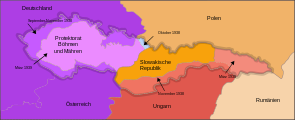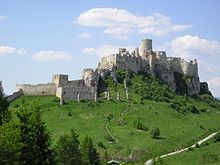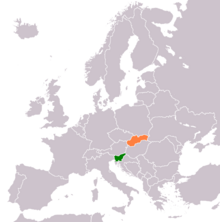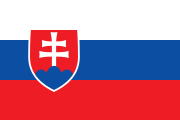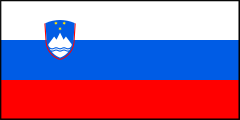German-Slovak relations


|
|
|
|
|
| Germany | Slovakia |
The German-Slovak relations are now marked by the partnership of Slovakia within the European Union with Germany as the largest economy of the Community. Within the EU, both countries have introduced the euro as their currency and participate in the Schengen Agreement . Outside the EU, they are members of the Council of Europe , the Organization for Security and Cooperation in Europe, and NATO . Germany and Slovakia are linked by the Danube shipping route .
The German Foreign Office assesses the relationship as "traditionally friendly".
history
(Eastern) Franconia and Moravia
Relations between Germany and Slovakia can be traced back historically to the predecessor states , namely the Moravian Empire (which comprised the territories of today's Slovakia and Moravia ) as well as the Franconian Empire and then the Eastern Franconia .
Sometime between 817 and 822 the Moravians recognized the sovereignty of the Bavarian- Franconian King Ludwig the German over their territory, as a result of which their messengers took part in the Landtag in Frankfurt in 822 .
The Christianization of the Moravians began in 831 with Prince Mojmir I and his surroundings being baptized by Bishop Reginhar von Passau . This princely decision was also binding for his subjects. Since then, the Passau bishops have included the Moravian areas in the Diocese of Passau .
In August 846, Ludwig the German moved with a Frankish army against the Moravians, deposed their ruler Mojmir I and installed his nephew Rastislav (846-870) as the new Moravian ruler, from whom Ludwig hoped greater vassal loyalty. The exact background that led to the deposition of Mojmir I is controversial among historians. Historian Eric J. Goldberg takes the view that Mojmir has become a serious threat to King Ludwig due to its policy towards a sovereign Christian-Slavic kingdom and has therefore been deposed. Dušan Třeštík counters this by saying that the formulation in the primary sources is too general and that Ludwig attacked the Moravians as part of an overall offensive against the neighboring Slavs.
In the early 850s, Rastislav began to lead a policy that was increasingly independent of Eastern France. In the year 855, Ludwig the German marched with a Frankish army against the Moravians, but was defeated by Rastislav's fortress. As a result, Rastislav was able to temporarily stop paying tribute to Eastern France and chased the entire Bavarian clergy out of his country. Rastislav's endeavors to withdraw his land from the Frankish sphere of influence with the help of Byzantium and the Eastern Church became of historical importance. After Pope Nikolaus I. Rastislav's request to send Slavic-speaking priests to build up his own Moravian church organization, Rastislav turned to the Byzantine Emperor Michael III in 862 . This corresponded to the demands of the Moravian prince and sent the Byzantine priests and scholars Kyrill and Method , who arrived in the Moravian Empire in 863. In 864, Louis the German attacked the Moravian Empire and forced Rastislav to surrender to the Devín . The expelled Bavarian clergy could now return to Moravia, but the work of Kyrill and Methods as well as the Slavic liturgy continued. Cyril and Method went to Rome in 867 in order to have their Slavic liturgical language legitimized by the Pope against the Bavarian clergy . In the same year Pope Hadrian II raised the Slavic liturgical language as equal with Latin, Greek and Hebrew. Two years later Kyrill died in Rome, his brother Method was appointed Moravian Archbishop (of the Moravian Empire and the Balaton Principality ) in 870 , but was only able to return to Moravia in 873 after three years imprisonment in Bavaria. Meanwhile, there had been a change of power in Moravia. After Ludwig the German was defeated again by Rastislav in another attack on Moravia in 869, he used his co-regent and nephew Svatopluk I to depose Rastislav in 870 and occupy the Moravian Empire. After Svatopluk was also accused of treason by the Eastern Franks in 871 and deposed and abducted as Moravian ruler, a successful anti-Frankish uprising broke out under the leadership of the Moravian prince Slavomir, as a result of which Svatopluk was dismissed and was again able to assert himself as prince of the Moravian Empire.
Svatopluk destroyed the Frankish occupation army in 871 and concluded a peace agreement with Ludwig the German in 874, which gave him extensive freedom of action while maintaining his loyalty to the Franks and paying tribute. After the agreement, Svatopluk began a rapid expansion of the Moravian Empire through wars of conquest and marriage policy. In the period from 874 to 884 Svatopluk was able to incorporate Wislan , Pannonia , the rear Tisza , Silesia , Bohemia and Lusatia into the Moravian Empire. The so created Slavic empire covered about 350,000 km² with about one million inhabitants. Svatopluk successfully fended off the attacks of the new East Franconian king Arnulf of Carinthia and the nomadic cavalry people of the Magyars , whom he called to Central Europe, in the years 892 to 893. Prince Svatopluk I died in 894, his successor on the Moravian throne was his eldest son Mojmir II (894–902 / 7). This immediately faced a number of initial problems, such as the detachment of conquered territories, the pressure of Eastern Franconia, the steadily increasing Magyar danger and internal conflicts. According to Dušan Třeštík, Mojmir II managed to cope with this skillfully from the start.
In the year of his father's death, he concluded a peace treaty with the East Franconian King Arnulf of Carinthia in order to be able to securely take over power in the Moravian Empire. After the Bishop Wiching (a Benedictine monk from the Reichenau Abbey on Lake Constance ) who was responsible for the Moravian Empire defected to King Arnulf in 893 , the Moravians had no recognized bishop. In a letter addressed to the Pope in 898/899, Mojmir II asked him to renew the Moravian Archdiocese. The Pope complied with Mojmir II's request and sent Archbishop John and Bishops Benedict and Daniel to Moravia. In 895 the Bohemians broke away from the Moravian Empire, whereupon Mojmir II led a futile campaign of reconquest against them. In 896, with the permission of the Moravians, the Magyars settled in the rear part of the Tisza and undertook joint raids against the Franks with the Moravians. In 897 the Sorbs also declared themselves independent from the Moravian Empire. In the Moravian Empire itself, meanwhile, a civil war broke out in 899 between Mojmir II and his brother Svatopluk II (894-899), who probably resided in Nitra , during which the Bavarian army liberated the defeated Svatopluk II and brought him to Bavaria. In the year 900 the Magyars occupied the Franconian Pannonia after a campaign in Italy in order to settle permanently in the Carpathian Basin .
According to the Czech historian Martin Wihoda, the increasing self-confidence of the Magyars forced the Moravians to act. At the beginning of the year 901 Mojmir II concluded a peace treaty with the Bavarians and with their help fended off a Magyar attack from the Pannonia ruled by them in 902. The stability in the central Danube region, which arose with the mutual peace agreement, also favored Bavarian-Moravian trade over the next few years, as evidenced by the Raffelstetten customs regulations . In 904, however, the Magyar prince Kurszán was murdered at a banquet table in Bavaria, whereupon the revenge of the Magyars was directed not only against the Bavarians, but also against the allied empire of Mojmir II. Dušan Třeštík suspects that the Moravian army was destroyed by the Magyars in 905–906 in a single battle near Nitra, in the course of which Mojmir II died. As a result of this catastrophe, according to archaeological sources, the Moravian Empire is said to have sunk into chaos and pagan uprisings. The devastating defeat of the Bavarians at the Battle of Pressburg in 907, in which they tried again to restore the old conditions, meant the final fall of the Moravian Empire.
High and late Middle Ages
The area of today's Slovakia was part of Hungary from 1108 at the latest until 1918 . The mining industry , which has been intensively practiced since the 11th century, and the German settlers who arrived especially since the 13th century (after the great Mongol invasion of 1241/1242, which depopulated the country ) made Slovakia in the Middle Ages , but also until the 18th century, that wealthiest area of the Kingdom of Hungary. German settlement reached its peak in the 14th century. In the area of Pressburg (Bratislava) there were probably Germans a little earlier. They mainly settled older Slovak cities (especially Pressburg), market and mining settlements and were mostly recruited by the kings as specialists (craftsmen, miners). Until about the 15th century, the ruling class of all Slovak cities consisted almost exclusively of Germans.
The three main settlement areas were Bratislava and the surrounding area, the German language islands in the Spiš ( Zipser Sachsen ) and the Hauerland . In addition, from the 18th century in the Carpathian Ukraine in the Teresva or Mokryanka Valley and near Munkatsch there were two other small German-speaking islands. Together, however, the inhabitants of the five settlement areas did not represent a homogeneous group, and often they did not even know each other.

The 11th and 12th centuries were a time of clashes between Hungary on the one hand and the Holy Roman Empire (which later also bore the addition of "German Nation") and / or Bohemia on the other, which often took place in Slovakia. In 1412 Sigismund of Luxemburg pledged some towns of the Spiš to Poland-Lithuania . The cities remained under Polish-Hungarian administration until 1772. From 1419–1437 Sigismund of Luxembourg had to fight the Czech Hussites in Slovakia as well . 1440–1453 the Czech nobleman Johann Giskra (Ján Jiskra) occupied Slovakia for the Habsburgs during the wars for the throne in the Kingdom of Hungary . From 1439 to 1806 the House of Habsburg provided the German kings and Roman-German emperors almost continuously, so that the rulers established close ties between the areas of what would later become Germany and what would later become Slovakia.
However, the Slovak territories never became part of the Holy Roman Empire (German Nation). The Habsburgs ruled Slovakia (also called " Upper Hungary") in their function as Hungarian kings.
Early modern age
After the Battle of Mohács (1526) , which ended with a victory for the Ottomans , and a subsequent civil war (1526–1538), the Kingdom of Hungary was divided into three parts. One of them was "Royal Hungary" (in fact a Habsburg province): today's Slovakia (except for Turkish areas in the extreme south of central Slovakia) and a small part in the north-east of today's Hungary with Burgenland and western Croatia . These were all areas that were almost exclusively inhabited by non- Magyars , Germans and Slavs.
Although Slovakia remained formally part of Hungary, more than 400 years of Magyar-influenced politics came to an end at the beginning of the 16th century with the Turkish conquest of today's Hungary, and a policy determined by the House of Habsburgs prevailed. Pressburg became the capital and coronation city of Hungary (1536) and Trnava (Eng. Tyrnau , Hungarian Nagyszombat ) became the seat of the archbishop (1541).
(As part of the Turkish Wars , the Habsburgs were able to conquer the rest of the Hungarian territories by 1699 ( Peace of Karlowitz ).) In 1784, as part of the Habsburgs Joseph II's efforts to centralize, German (instead of Latin ) became the official and teaching language in the Kingdom of Hungary (and thus in Slovakia) (repealed in 1790). The result, as a counter-movement, was increasing Magyar nationalism . In 1790 and 1792 the Diet passed the first laws promoting the Hungarian language at the expense of the other languages used in the kingdom. This marked the beginning of the Magyarization of the kingdom's non-Magyar population, which then gradually increased in the 19th century.
The official language in Slovakia was 1849-1868 again German (language of the courts predominantly Hungarian ), and also in contact with the simple Slovak population Slovak tolerated. German and Hungarian were the official languages from 1860 to 1868. From 1868 on, Hungarian was the almost exclusively official language. In 1907, with the Appony School Acts (named after the then School Minister Albert Apponyi ), the climax of Magyarization followed: Due to this law, Slovak and German were only allowed to be taught as a foreign language for one hour per week. The laws at the world-famous mining academy in Banská Štiavnica , where the numerous foreign students, especially Germans, could no longer follow the lectures and had to move (mostly to Vordernberg or Leoben in Styria ) , had extremely negative consequences .
Slovakia as part of Czechoslovakia (1918–1939)
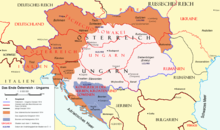
At the end of the First World War , groups of Czechs and Slovaks living in exile in the USA agreed in the Treaty of Pittsburgh on cooperation in building a future common state. Czechoslovakia was founded on October 28, 1918 . The international recognition of the new state took place in the Treaty of Saint-Germain (dissolution of the Austrian multi-ethnic state) and the Peace of Trianon (separation of Slovakia from Hungary). However, 23 percent of Germans and 5 percent of Hungarians, as well as some other minorities, lived in the newly founded state. The German population, which until then had belonged to the ruling nationality , was now suppressed. In Slovakia there was growing dissatisfaction with the guaranteed but not granted autonomy. Thus, with the Slovak People's Party, a Slovak autonomy movement came into being.
With the seizure of power of the Nazis in the German Reich in 1933 there aggressive, revisionist, the results came the First World War not appreciative government under Adolf Hitler to power. Czechoslovakia, with its strong German minority, as a neighbor of Germany, was a particularly suitable target for Hitler. He was able to use the discrimination against Germans there for his goals. Shortly after the Munich Agreement came into force on September 30, 1938 under German pressure (which sealed the cession of the predominantly German-settled, previously Czech Sudetenland to Germany), Slovakia was granted autonomy . It lost its southern territories to Hungary due to the First Vienna Arbitration Award of November 2, 1938 (which was decided by the Foreign Ministers of the German Reich ( Joachim von Ribbentrop ) and Italy ( Galeazzo Ciano )).
Slovak "independence" and World War II
Protectorate of Bohemia and Moravia and the Slovak Republic 1939

Under pressure from Adolf Hitler , who threatened to divide the country between Poland and Hungary, and Czech troops who had advanced on Slovak territory, the Slovak parliament declared Slovakia on March 14, 1939 the Slovak Republic , later called the First Slovak Republic , for independent. The state was under the strong influence of the German Reich, with which it concluded a so-called protection treaty shortly after the declaration of independence on March 23rd . This gave Germany far-reaching opportunities to influence the Slovak economy and foreign policy. In addition, the German Reich was allowed to militarily occupy a strip along the border with Moravia (following the course of the eastern fringes of the Little and White Carpathians and the Javorník Mountains ) as a "protection zone". The German declaration to protect the integrity of Slovak territory soon proved ineffective when Hungary attacked from the east and occupied parts of eastern Slovakia (see Slovak-Hungarian War ). In 1939, German troops attacked Poland from Slovakia and with the participation of Slovak associations. By 1944 at the latest, the National Socialist genocide as a result of the Slovak National Uprising was systematically extended to Slovakia.
Deportations of the Slovaks or the Roma did not take place. However , after constant pressure from the Reich, the Jews were recorded by the police and deported to concentration camps abroad (the planned labor camps for Jews were then not established). At least 57,000 Jews had been deported from Slovakia by October 1942. However, after it became public what kind of “labor camp” abroad it was in reality, the transports were stopped. The deportations were resumed at the end of 1944. The reason for this was the military occupation of the whole of Slovakia by the German Wehrmacht after the Slovak National Uprising (and the access of the SS and SD as a result). Many Slovaks were involved in this militarily failed but important uprising against Hitler in the post-war period in August 1944.
Slovakia as part of communist Czechoslovakia
Slovakia was occupied by Soviet troops in 1945 and the Czechoslovak Republic was restored. The German population, including large parts of the Carpathian Germans and the Zipser , was expelled. In 1948 the Communist Party took power. However, GDR troops were not allowed to participate in the crackdown on the Prague Spring , a movement in Czechoslovakia for “socialism with a human face” by the Warsaw Pact states under the leadership of the Soviet Union . Presumably, in the 30th year after the Munich Agreement , the citizens of the Czechoslovakia should not be embittered by the sight of invaders in German uniforms.

The Prague Spring and its suppression were observed and commented on in the Federal Republic of Germany like hardly any other foreign policy event. The interest in actually all parts of the public was similar: Both the large conservative newspapers and the small left-opposition papers put the events on their front pages. On the one hand, the bourgeois press observed the Czechoslovakian attempt to create “socialism with a human face” with great sympathy and almost entirely positive comments, but interpreted the reforms as an attempt to catch up with the western standards of freedom and democracy. In contrast, the extra-parliamentary opposition in the Federal Republic suddenly discovered a “third way” in the Prague Spring , a “hitherto undiscovered socialist democracy ”.
Post-communism and independent Slovakia
Czechs and Slovaks were able to free themselves from the communist dictatorship through the Velvet Revolution in November and December 1989.
As early as February 12, 1991, the Slovak parliament issued a statement regretting the "injustice in connection with expulsions" inflicted on ethnic Germans at the end of the Second World War, which had a positive impact on bilateral relations.
On January 1, 1993, Czechoslovakia was peacefully divided into the Czech Republic and the Slovak Republic. From now on, the young state could conduct its foreign policy independently.
However, the country's European integration was severely delayed until 1998 by the autocratic and nationalist government of Prime Minister Vladimír Mečiar . It was not until the parliamentary elections in September 1998 that a pro-Western government came to power, which made the country's integration into the West a top foreign policy priority.
As a result of the EU expansion on May 1, 2004 , Slovakia and nine other countries became a member of a large common economic area with Germany, which was reunified since 1990, as the largest economy.
As part of NATO's eastward expansion , Slovakia joined the North Atlantic Pact Organization on March 29, 2004 along with six other European reform states . (West) Germany has been a member of NATO since 1955.
The fact that Slovak foreign policy is also willing to set its own course is shown by the introduction of the common currency, the euro, in 2009. In the case of the "big neighbor" Czech Republic, however, it is still unclear in 2018 whether the Czech crown will ever be replaced.
2018 marks the 25th anniversary of the establishment of bilateral relations between Germany and Slovakia, which became independent in 1993. The Foreign Office points out that "on this occasion [...] on August 4, 2017, the in-depth dialogue between the two countries was launched".
economy
Economic cooperation between the two states can develop freely within the European Customs Union and the European internal market (free movement of goods, services, capital and people) of the European Union. The common currency “ Euro ”, which Slovakia joined in 2009, also eliminates intra-Community exchange rate risks and the resulting currency hedging for German and Slovak companies.
According to a survey carried out by the German-Slovak Chamber of Commerce and Industry in March 2010, 92 percent of local German entrepreneurs would choose Slovakia again as an investment location today. In comparison with the Central and Eastern European countries as well as Germany and China, the Slovak Republic comes off as the most attractive location. With a score of 2.19, it is well ahead of the Czech Republic (2.47), Poland (2.67), Slovenia (2.70) and Hungary (3.39). The IMF and the OECD also declared the end of 2004 Slovakia for the "reform-" of its member countries.
| Export (in percent) to | Import (in percent) of | ||
|---|---|---|---|
|
|
21.9 |
|
20.2 |
|
|
11.9 |
|
16.9 |
|
|
7.7 |
|
9.8 |
|
|
6.1 |
|
6.4 |
|
|
5.9 |
|
6.1 |
|
|
5.7 |
|
4.7 |
|
|
5.7 |
|
4.6 |
| other countries | 35.1 | other countries | 31.3 |
An important German company in Slovakia is Volkswagen Slovakia , a wholly-owned subsidiary of Volkswagen AG with its headquarters in Martin . Opened on June 1, 2000, the plant is one of 20 component locations and a member of the production network in the VW Group.
According to the Foreign Office , "500 German companies have invested and created around 100,000 jobs in independent Slovakia by 2018".
Culture, science and media
Cultural and scientific contacts
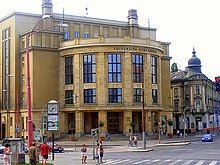
The German-Slovak cultural relations are historical and a. shaped by the geographical proximity, by the long rule of the Habsburgs over Slovak territories and the associated great importance of the German language as a language of culture and science over many centuries. So was z. For example, the language of instruction at the Mining Academy in Banská Štiavnica was German for a long time.
Nowadays the Goethe-Institut in Bratislava serves the cultural exchange and the promotion of German culture in Slovakia.
As the Foreign Office writes, "German [after English] is the second most important foreign language in [Slovak] schools". The German-Slovak meeting school in Bratislava and the state high school Tatarku Poprad should be emphasized . For the Slovak students it is possible there to do the German Abitur .
At the Ludwig Maximilians University in Munich , the Slovak language can be learned as part of the Slavic philology. Language studies are also possible at the Humboldt University in Berlin .
A total of ten universities in Slovakia offer German studies.
media
The Carpathian Gazette is published for the German minority in Slovakia. The Pressburger Zeitung reports every two months on cross-border topics. Other periodicals are the Pressburg University Newspaper, the Review of Slovak Literature and the Slovak Monthly Report.
Work and life
As part of the EU free movement of workers , Germans can work in Slovakia and Slovaks in Germany without any problems.
Germany was one of the EU-15 states that sealed off their labor market the most in the course of the EU enlargement in 2004 , during which Slovakia also joined the community. The topic had been discussed controversially in advance, and the fear was expressed that the German labor market would not be able to cope with a "rush" and that there could be increased unemployment among the local population. According to this, Germany restricted access to its labor market under the 2-3-2 formula and, together with Austria, was one of the two countries for which full freedom of movement did not apply until May 1, 2011. The restrictions on the free movement of workers were not reciprocal in the case of Slovakia; This means that Slovakia for its part did not restrict access to its labor market for members of the "old" EU-15.
Transport, travel and tourism
Street
Since both states have joined the Schengen area, their citizens are free to travel; an identity card is sufficient to enter the country. Normally there should be no more border controls. However, since the refugee crisis in Europe from 2015 there have been more controls at the German-Austrian border and thus on the way from Slovakia to Bavaria.
A fast connection on the road between southern Germany or Switzerland and Slovakia is the Austrian West Autobahn to Vienna and then the East Autobahn as well as the Northeast Autobahn towards Bratislava.
Between northern Germany and Slovakia, individual traffic can use the route via Dresden and Prague ( European route 55 ), then Dálnice 1 to Brno ( European route 50 ) and from there the European route 65 to the Slovak capital.
rail
Several important national and international railway lines meet at the main railway station in Bratislava , including European main lines such as:
- Berlin - Prague - Brno - Bratislava - Budapest (- Bucharest ): Pan-European Transport Corridor No. VI ,
- Prague - Bratislava - Budapest - Belgrade
- Vienna - Bratislava - Žilina - Katowice (Poland) (corridor No. VI) or Žilina - Košice - Uschhorod (Ukraine) (corridor No. Va)
If you are coming from southern Germany, western Austria and Switzerland, you have to change trains in Vienna. A continuous Eurocity runs between Berlin and Bratislava .
air traffic
There are direct connections to and from Bratislava Airport with Berlin-Schönefeld Airport ( Ryanair ). Vienna and Bratislava are so close to each other that they can be described as twin cities, although the two cities are not directly adjacent, but are the closest capitals in Europe (with the exception of the Vatican and Rome ). Therefore, western Slovakia can also be reached very easily by flying to Vienna.
There is a direct flight between Cologne and Košice with Wizzair .
On the water
The Danube connects southern Germany via Austria with the port of Bratislava and the port in Komárno . Numerous river cruises are offered as part of passenger shipping on the Danube . B. begin in Passau and where the ships often anchor in Bratislava.
The river between the mouth of the Danube near the Romanian Sulina via Bratislava to Kelheim in Lower Bavaria is navigable for large cargo ships. You can then use the Rhine-Main-Danube Canal to reach the economic centers of western Germany (e.g. the Ruhr area ), the Netherlands and the North Sea .
By bicycle

Southern Germany is connected to Bratislava and western Slovakia by the Danube Cycle Route via Austria (with scenic highlights such as the Schlögener Danube loop and the Wachau ).
On foot
The International Mountain Hiking Trail Eisenach – Budapest runs through Slovakia .
tourism
138,000 German tourists visited Slovakia in 2014. This made them the third largest group of visitors after the Czechs and Poles. In the context of tourism in Slovakia , cities and castles as well as nature experiences z. B. in the Tatra Mountains .
Sports
Soccer
At the European Football Championship 2016 in France, the Slovak selection failed in the round of 16 with 0: 3 to Germany.
The football player Fritz Balogh (1920–1951) was bid in Bratislava. In 1950 he played an international match for the German national soccer team . In club football he played for Hertha BSC, among others .
The German table tennis player Leopold Holusek (1924–1993) was also born in Bratislava. He was a three-time German champion in doubles.
Mutual perception: likelihood of confusion with Slovenia
Some Germans have difficulties telling Slovakia and Slovenia apart, which can cause displeasure among the Slovaks. In fact, both country names come from the original name of all Slavs, the Sloveni . The fact that the Slovak name for their country is "Slovensko" does not add to the relief of the situation.
Both states rely on a Slavic identity, with the Slovaks being counted among the Western Slavs and the Slovenes among the Southern Slavs . Up to the First World War , both Slovakia and Slovenia were part of Austria-Hungary , with Slovakia belonging to the Kingdom of Hungary and Slovenia to the Austrian-dominated Cisleithanien . Both countries were also part of a larger state for much of the 20th century: Slovakia was integrated into Czechoslovakia , Slovenia into Yugoslavia . Slovenia fought for its independence in short battles against the Yugoslav People's Army (JNA) in the 10-day war (declaration of independence on June 25, 1991). Slovakia achieved its independence peacefully on January 1, 1993.
The flag of Slovakia uses the Pan-Slavic colors white-blue-red.
The flag of Slovenia also uses these colors and is therefore easy to confuse.
The coat of arms of Slovakia is different a. by the patriarchal cross from its Slovenian counterpart. The Dreiberg symbolizes the three mountains of the northern Kingdom of Hungary, namely the Tatra , Fatra and Mátra .
In the coat of arms of Slovenia, however , the three mountain peaks stand for the Triglav in the Julian Alps .
Germans in Slovakia, Slovaks in Germany
A German minority in Slovakia: the Carpathian Germans
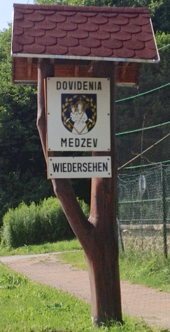
From the large, long-established German minority in Slovakia (see the section "History"), there is hardly anything left after the turmoil of the 20th century - especially after the flight and expulsion at the end of the Second World War: Today, according to a census, only people are left fewer than 6,000 Germans in Slovakia, who have enjoyed all political rights since the Velvet Revolution . The Karpatendeutsche Landsmannschaft in Stuttgart works with the Karpatendeutsche Verein in Slovakia and its youth association and with the Slovak government. a. Maintenance of tradition. A major challenge is the assimilation of the middle and younger generations to the Slovak environment, which in most cases means the loss of the German language and customs.
However, there are still two Carpathian German villages, Hopgarten and Metzenseifen . In Hopgarten, the majority of the population is still German-speaking.
The most prominent member of this ethnic group is Rudolf Schuster , 1999–2004 Slovak President.
There is a collection of material on the Carpathian German dialects from the 1950s and 1960s in the editorial office of the Sudeten German dictionary , which has not yet been scientifically processed.
However, the Carpathian German Association (KDV) with around 4,800 members and the Slovak government estimate that the proportion of Germans is around 10,000–12,000 people.
The Zipser represent a special German population group .
Slovaks in Germany
According to the Central Register of Foreigners , there were 53,440 Slovaks living in Germany in 2016.
people
Personalities born in Bratislava with ties to Germany
(Austrians are also generally not taken into account for the time of the Holy Roman Empire or the German Confederation , although the delimitation naturally cannot always be clear):
- Hans Neusidler (1508 / 09–1563), German lute singer
- Christoph Preuss von Springenberg (1515–1590), poet and rhetorician
- Daniel Wilhelm Moller (1642–1712), German polyhistor
- Rudolf Wilhelm von Stubenberg (1643–1677), member of the Fruit Bringing Society
- Johann Sigismund Kusser (1660–1727), German conductor and composer
- Georg Christian Maternus de Cilano (1696–1773), city physician, judiciary, writer and librarian
- Johann Andreas von Segner (1704–1777), mathematician, physicist and doctor
- Karol Andrej Bel (1717–1782), historian
- Adam Friedrich Oeser (1717–1799), German painter, sculptor and book illustrator

- Johann Matthias Matsko (1721–1796), German astronomer, mathematician and university professor.
- Karl Gottlieb von Windisch (1725–1793), businessman, private scholar, editor and historian
- Ferdinand Laban (1856–1910), German writer, art historian and librarian
- Philipp Lenard (1862–1947), German physicist
- Arnold Pressburger (1885–1951), Austrian-German film producer
- Fritz Balogh (1920–1951), German football player
- Leopold Holusek (1924–1993), German table tennis player
- Tibor Kneif (1932–2016), Hungarian lawyer and German musicologist
- Adalbert Mayer-Heinricy (* 1934), German biophysicist
- Peter Gavajda (1942–2011), German actor
- Malte Ludin (* 1942), German director and producer
- Norbert Skrovanek (* 1954- † November 11, 2014 in Hamburg ), German television director, screenwriter, producer and university lecturer
Personalities born in Košice
- Rudolf Schuster , from 1999 to 2004 the second President of Slovakia , born January 4, 1934 , member of the Carpathian German minority
Town twinning
-
Bratislava maintains friendly relations with Bremen (inactive), Karlsruhe and Ulm (cooperation agreement, Danube partnership).
 The Neustadt in Europa amalgamation , the largest city friendship in Europe , includes various German "Neustädten" as well as the Slovakian Nové Mesto nad Váhom (Neustadt (l) an der Waag)
The Neustadt in Europa amalgamation , the largest city friendship in Europe , includes various German "Neustädten" as well as the Slovakian Nové Mesto nad Váhom (Neustadt (l) an der Waag)
- The city of Košice maintains a twinning relationship with the following German cities: Cottbus and Wuppertal .
Institutions
- German-Slovak encounter school in Bratislava
- German-Slovak Historical Commission
- German-Slovak Chamber of Commerce and Industry
- German-Slovak parliamentary group
- German-Czech and -Slowakische company e. V. (DTSG)
- Carpathian German country team
Diplomatic missions
- Slovakia has an embassy in Berlin , a consulate general in Munich, and honorary consulates in Bad Homburg , Hildesheim , Leipzig and Stuttgart .
- Germany operates an embassy in Pressburg and an honorary consulate in Kosice .
See also
Web links
- Information from the German Foreign Office on relations with Slovakia
- The Slovak ambassador in Berlin on bilateral relations
Individual evidence
- ↑ a b c d e Foreign Office: Foreign Office - Relations with Germany. Retrieved January 20, 2018 .
- ↑ Třeštík: Vznik Velké Moravy, S. 125th
- ^ Ján Steinhübel: The Great Moravian Dioceses. P. 5 , accessed on January 16, 2018 .
- ^ Goldberg: Struggle for the Empire , p. 138, Třeštík: Vznik Velké Moravy , pp. 147–155, Třeštík: Počátky Přemyslovců , p. 272.
- ↑ Hoensch: History of Bohemia , p. 36.
- ↑ Kováč: Dejiny Slovenska , p. 30.
- ↑ Havlík: Svatopluk Veliký , p. 27.
- ↑ Havlík: Svatopluk Veliký , p. 8.
- ↑ Třeštík: Vznik Velké Moravy , pp. 199–200.
- ↑ Třeštík: Počiatky Přemyslovců , pp 280-281.
- ↑ Havlík: Kronika o Velké Moravě , p. 363, Steinhübel: Nitrianske kniežatstvo , p.
- ↑ Třeštík: Počiatky Přemyslovců , pp 280-282.
- ↑ a b Třeštík: Počátky Přemyslovců , p. 285.
- ^ Vlasto: The Entry of the Slavs , p. 83.
- ↑ Wihoda: Morava v Dobe Knížecí , S. 87th
- ^ Třeštík: Počátky Přemyslovců , pp. 286–287.
- ↑ Ernst Fischer : No Romantics in Prague , in: Neues Forum, Issue 173, 5/1968, p. 284
- ↑ GTAI - compact economic data. Germany Trade and Invest GmbH, accessed on September 24, 2017 .
- ^ Slovak - Slavic Philology - Slavic Studies - LMU Munich. Retrieved January 20, 2018 .
- ^ Robert Hammel: The study of the Slovak language and literature at the Humboldt University - Institute for Slavic Studies. Retrieved January 20, 2018 .
- ↑ Information. In: sung.sk. Retrieved January 21, 2018 .
- ↑ karpatenblatt.sk - magazine of Germans in Slovakia. Retrieved January 20, 2018 .
- ↑ press-guide.com - German-language newspapers in Slovakia. Retrieved January 20, 2018 .
- ↑ Welt.de: Federal Agency raves about the influx from Eastern Europe .
- ↑ In the center of a European core area ( Memento of the original from October 26, 2014 in the Internet Archive ) Info: The archive link was automatically inserted and not yet checked. Please check the original and archive link according to the instructions and then remove this notice. Retrieved July 5, 2010.
- ^ Slovak Republic in OECD Tourism Trends and Policies. (PDF) (No longer available online.) In: http://www.oecd-ilibrary.org/ . OECD, p. 263 , formerly in the original ; accessed on January 20, 2018 . ( Page no longer available , search in web archives ) Info: The link was automatically marked as defective. Please check the link according to the instructions and then remove this notice.
- ↑ Hans-Jörg Schmidt: Annoying, but correct: How to bring Slovaks to white heat . In: The world . January 16, 2015 ( welt.de [accessed January 14, 2018]).
- ↑ Proportion of foreigners in Germany until 2016 | Statistics. Retrieved January 20, 2018 .
- ↑ Korko: German School Bratislava. Retrieved January 16, 2018 .
- ^ German-Czech and German-Slovak Commission of Historians. Retrieved January 16, 2018 .
- ↑ AHK Slovakia. Retrieved January 16, 2018 .
- ^ Sandra Schmid: German Bundestag - advocate and mediator of Slovak concerns . In: German Bundestag . ( bundestag.de [accessed January 20, 2018]).
- ↑ DTSG_home. Retrieved January 16, 2018 .
- ^ The Carpathian Germans - Karpatendeutsche Landsmannschaft. Retrieved January 20, 2018 .
- ↑ Gymnázium, bilingválna sekcia. Retrieved January 16, 2018 .
- ^ Embassy of the Slovak Republic in Berlin. Retrieved January 14, 2018 .
- ↑ a b Foreign Office - Slovakia. Federal Foreign Office, accessed on January 14, 2018 .




